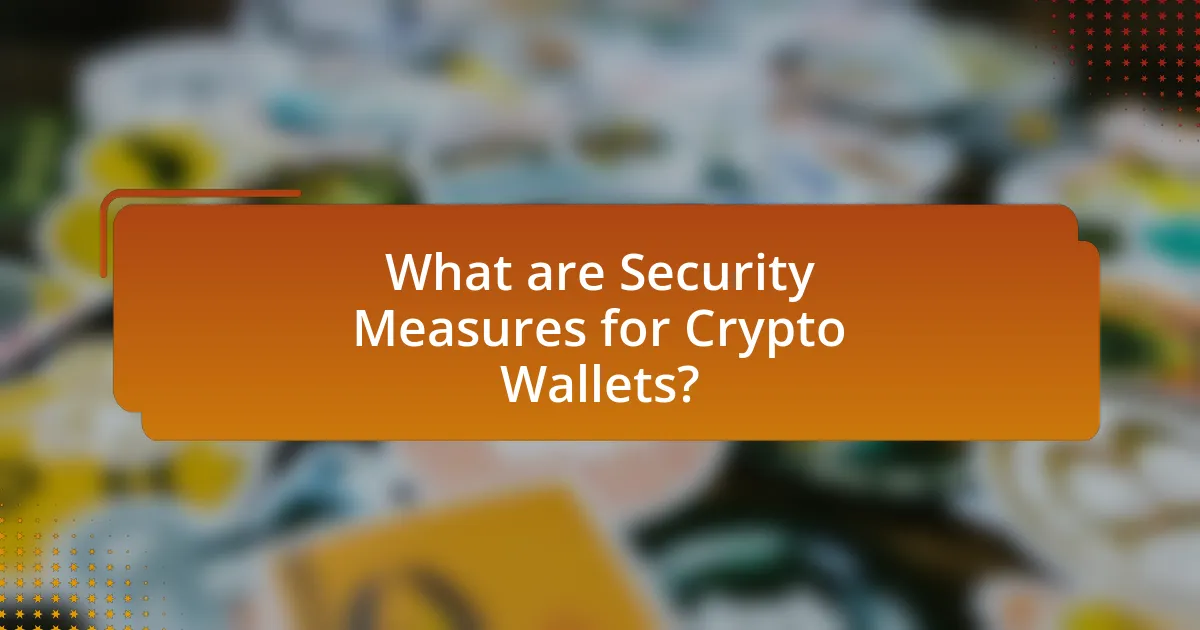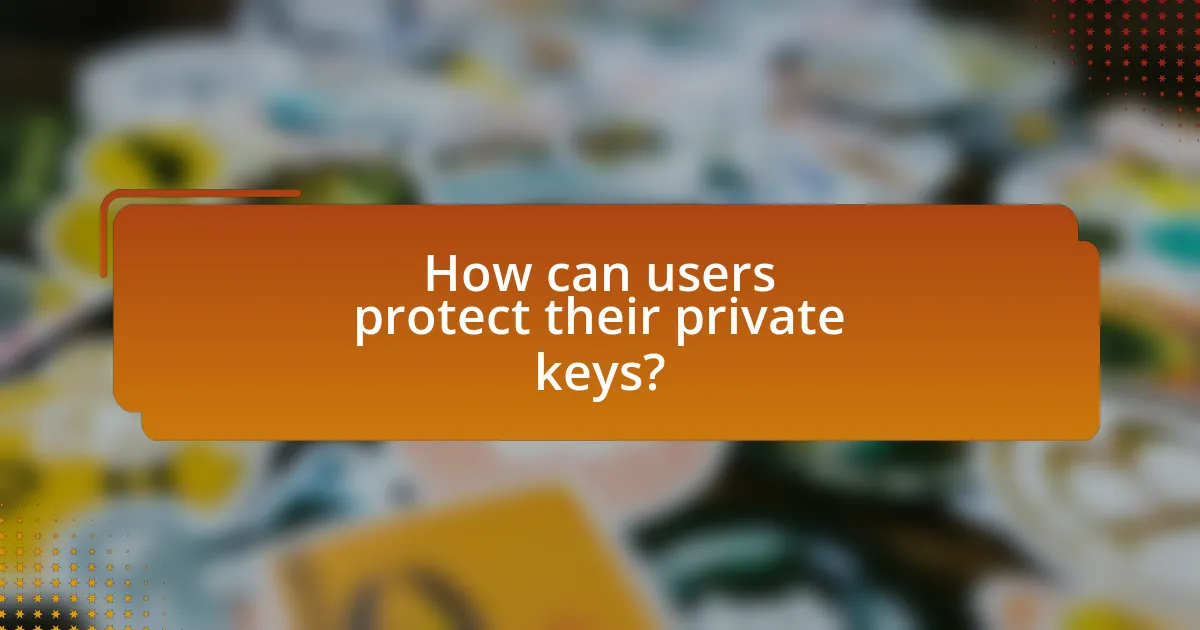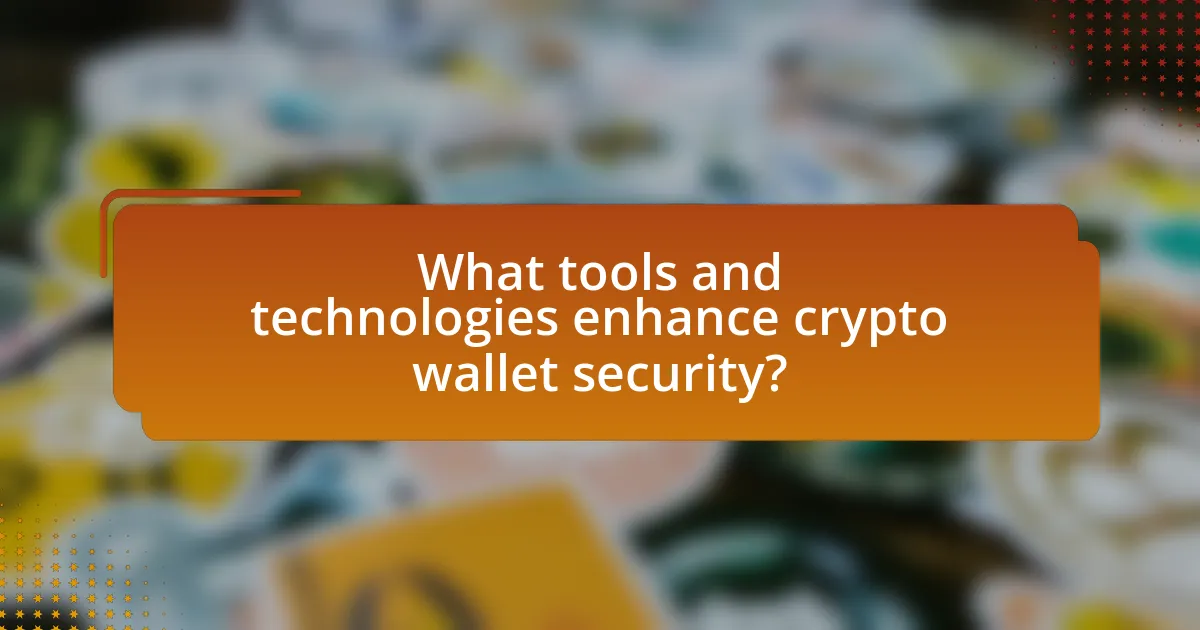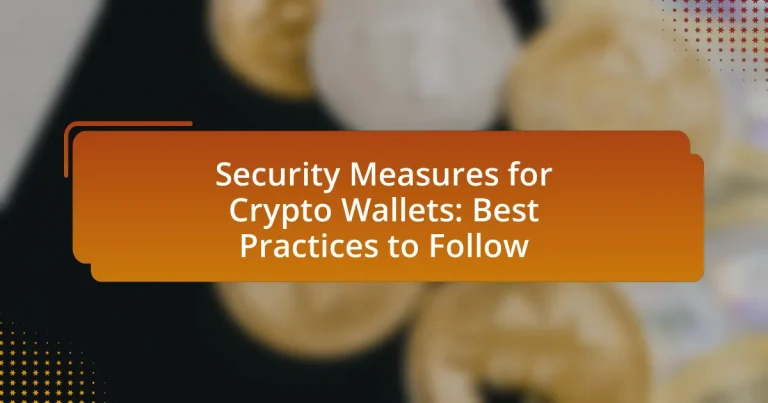The article focuses on security measures for crypto wallets, emphasizing the importance of protecting digital assets from theft and unauthorized access. Key topics include the necessity of strong passwords, two-factor authentication (2FA), regular software updates, and the use of hardware wallets for enhanced security. It outlines the risks associated with inadequate security, such as hacking and phishing attacks, and discusses best practices for safeguarding private keys. Additionally, the article explores different types of wallets, the role of encryption and blockchain technology in security, and common mistakes to avoid in wallet management.

What are Security Measures for Crypto Wallets?
Security measures for crypto wallets include using strong passwords, enabling two-factor authentication (2FA), keeping software updated, and using hardware wallets for enhanced security. Strong passwords reduce the risk of unauthorized access, while 2FA adds an extra layer of protection by requiring a second form of verification. Regular software updates patch vulnerabilities, and hardware wallets store private keys offline, minimizing exposure to online threats. According to a report by CipherTrace, over $1.9 billion was lost to cryptocurrency theft in 2020, highlighting the importance of these security measures in protecting digital assets.
Why are security measures essential for crypto wallets?
Security measures are essential for crypto wallets to protect digital assets from theft and unauthorized access. The decentralized nature of cryptocurrencies makes them vulnerable to cyberattacks, with reports indicating that over $1.9 billion was stolen from crypto exchanges and wallets in 2020 alone. Implementing strong security protocols, such as two-factor authentication, encryption, and regular software updates, significantly reduces the risk of breaches and ensures the safety of users’ funds.
What risks do crypto wallets face without proper security?
Crypto wallets face significant risks without proper security, including theft, loss of funds, and unauthorized access. Without robust security measures, such as two-factor authentication and encryption, wallets become vulnerable to hacking attempts. For instance, in 2021, the Poly Network hack resulted in the theft of over $600 million in cryptocurrencies due to inadequate security protocols. Additionally, users may fall victim to phishing attacks, where malicious actors impersonate legitimate services to steal private keys. These risks highlight the critical need for stringent security practices to protect digital assets effectively.
How can security measures mitigate these risks?
Security measures can mitigate risks associated with crypto wallets by implementing robust authentication protocols, encryption, and regular software updates. For instance, two-factor authentication (2FA) significantly reduces unauthorized access by requiring a second form of verification, which has been shown to decrease account breaches by up to 99%. Additionally, encryption protects sensitive data, making it unreadable to unauthorized users, while regular software updates patch vulnerabilities that could be exploited by attackers. These combined measures create a multi-layered defense, effectively reducing the likelihood of theft and loss of assets in crypto wallets.
What types of crypto wallets exist?
There are three main types of crypto wallets: hot wallets, cold wallets, and hardware wallets. Hot wallets are connected to the internet and allow for quick access and transactions, making them convenient for frequent trading. Cold wallets, on the other hand, are offline and provide enhanced security against online threats, making them suitable for long-term storage of cryptocurrencies. Hardware wallets are a specific type of cold wallet that store private keys on a physical device, offering a high level of security due to their offline nature.
What are the differences between hot wallets and cold wallets?
Hot wallets are online cryptocurrency wallets that are connected to the internet, allowing for quick and easy access to funds, while cold wallets are offline storage solutions that provide enhanced security by keeping private keys disconnected from the internet. The primary difference lies in their connectivity; hot wallets facilitate immediate transactions but are more vulnerable to hacking, whereas cold wallets, such as hardware or paper wallets, offer greater protection against cyber threats due to their offline nature. This distinction is crucial for users to understand when managing their cryptocurrency assets, as the choice between hot and cold wallets directly impacts the security and accessibility of their funds.
How do hardware wallets enhance security compared to software wallets?
Hardware wallets enhance security compared to software wallets by storing private keys offline, which significantly reduces the risk of hacking. Unlike software wallets that are connected to the internet and can be vulnerable to malware and phishing attacks, hardware wallets keep sensitive information isolated from online threats. For instance, hardware wallets utilize secure elements and encryption to protect private keys, making unauthorized access extremely difficult. According to a study by the European Union Agency for Cybersecurity, hardware wallets are considered one of the most secure methods for storing cryptocurrencies due to their offline nature and robust security features.
What are the best practices for securing crypto wallets?
The best practices for securing crypto wallets include using hardware wallets, enabling two-factor authentication, regularly updating software, and keeping private keys confidential. Hardware wallets, such as Ledger or Trezor, store private keys offline, significantly reducing the risk of hacking. Two-factor authentication adds an extra layer of security by requiring a second form of verification, making unauthorized access more difficult. Regular software updates ensure that any vulnerabilities are patched, protecting against potential exploits. Additionally, users should never share their private keys and should store them in a secure location, as exposure of these keys can lead to loss of funds. These practices are supported by cybersecurity experts who emphasize the importance of multi-layered security in protecting digital assets.
How can users create strong passwords for their wallets?
Users can create strong passwords for their wallets by combining a mix of uppercase and lowercase letters, numbers, and special characters, while ensuring the password is at least 12 characters long. This complexity makes it significantly harder for attackers to guess or crack the password. According to a study by the National Institute of Standards and Technology (NIST), longer passwords that include a variety of character types are more secure, as they exponentially increase the number of possible combinations, making brute-force attacks less feasible. Additionally, users should avoid using easily guessable information, such as birthdays or common words, to further enhance password strength.
What role does two-factor authentication play in wallet security?
Two-factor authentication (2FA) significantly enhances wallet security by requiring two forms of verification before granting access. This additional layer of security mitigates the risk of unauthorized access, as even if a password is compromised, the attacker would still need the second factor, typically a code sent to a mobile device or generated by an authentication app. According to a study by Google and the University of California, Berkeley, 2FA can block 99.9% of automated attacks, demonstrating its effectiveness in protecting sensitive information, including cryptocurrency wallets.

How can users protect their private keys?
Users can protect their private keys by employing secure storage methods, such as hardware wallets, which store keys offline and are less susceptible to hacking. Additionally, users should enable two-factor authentication (2FA) on their wallets to add an extra layer of security. Regularly updating software and using strong, unique passwords further enhances protection against unauthorized access. According to a report by the Cybersecurity & Infrastructure Security Agency, using hardware wallets significantly reduces the risk of key theft compared to software wallets.
What are the best methods for storing private keys securely?
The best methods for storing private keys securely include using hardware wallets, paper wallets, and secure password managers. Hardware wallets, such as Ledger or Trezor, store private keys offline, significantly reducing the risk of online hacks. Paper wallets involve generating and printing private keys offline, ensuring they are not exposed to digital threats. Secure password managers, like Bitwarden or LastPass, encrypt private keys and require strong master passwords, providing an additional layer of security. These methods are validated by their widespread adoption in the cryptocurrency community, where security breaches often stem from poor key management practices.
How does using a password manager help in key management?
Using a password manager enhances key management by securely storing and organizing cryptographic keys and passwords in an encrypted format. This ensures that users can access their keys easily while minimizing the risk of unauthorized access or loss. Password managers often employ strong encryption algorithms, such as AES-256, to protect stored data, making it significantly more difficult for attackers to retrieve sensitive information. Additionally, many password managers offer features like password generation and automatic filling, which help users create strong, unique passwords for each account, further strengthening overall security.
What are the risks of sharing private keys with others?
Sharing private keys with others poses significant risks, primarily the loss of control over one’s cryptocurrency assets. When a private key is shared, the recipient gains full access to the associated wallet, enabling them to transfer or spend the funds without the original owner’s consent. This vulnerability is underscored by the fact that once a private key is compromised, it cannot be revoked or changed, leading to potential theft or unauthorized transactions. According to a report by Chainalysis, over $3.2 billion in cryptocurrency was stolen in 2021, often due to poor security practices, including sharing private keys. Therefore, maintaining the confidentiality of private keys is crucial for safeguarding digital assets.
What should users do if they suspect their wallet has been compromised?
Users should immediately cease all transactions and transfer their assets to a secure wallet if they suspect their wallet has been compromised. This action minimizes potential losses and protects remaining funds. Following this, users should change their wallet passwords and enable two-factor authentication to enhance security. Additionally, users should monitor their accounts for any unauthorized activity and report any suspicious transactions to the wallet provider. According to cybersecurity experts, prompt action can significantly reduce the risk of further losses in compromised situations.
What immediate actions should be taken to secure funds?
To secure funds immediately, users should enable two-factor authentication (2FA) on their crypto wallets. This action significantly reduces the risk of unauthorized access, as it requires a second form of verification beyond just a password. According to a study by Google, 2FA can block 99.9% of automated attacks, demonstrating its effectiveness in enhancing security. Additionally, users should regularly update their wallet software to protect against vulnerabilities, as outdated software can be exploited by hackers. Implementing these measures ensures a robust defense against potential threats to crypto assets.
How can users recover lost or stolen crypto assets?
Users can recover lost or stolen crypto assets by following specific steps, including reporting the incident to the relevant cryptocurrency exchange or wallet provider, utilizing recovery phrases or private keys, and contacting law enforcement if theft is suspected. Reporting to the exchange or wallet provider is crucial as they may have protocols in place to assist users in recovering their assets. Recovery phrases or private keys, which are often provided during the initial setup of a wallet, can restore access to funds if the wallet is lost. Additionally, involving law enforcement can help in tracking stolen assets, especially if the theft involves significant amounts or fraudulent activity.

What tools and technologies enhance crypto wallet security?
Tools and technologies that enhance crypto wallet security include hardware wallets, multi-signature authentication, and encryption protocols. Hardware wallets, such as Ledger and Trezor, store private keys offline, significantly reducing the risk of hacking. Multi-signature authentication requires multiple keys to authorize a transaction, adding an extra layer of security. Encryption protocols, like AES (Advanced Encryption Standard), protect sensitive data within wallets, ensuring that even if data is intercepted, it remains unreadable. These methods collectively strengthen the security framework of crypto wallets, making unauthorized access more difficult.
How do encryption and blockchain technology contribute to wallet security?
Encryption and blockchain technology significantly enhance wallet security by ensuring data confidentiality and integrity. Encryption protects sensitive information, such as private keys, by converting it into an unreadable format that can only be decrypted with a specific key, thus preventing unauthorized access. Blockchain technology, on the other hand, provides a decentralized and immutable ledger that records all transactions, making it nearly impossible for malicious actors to alter transaction history or compromise wallet data. The combination of these technologies creates a robust security framework; for instance, a study by the Cambridge Centre for Alternative Finance indicates that the use of encryption and blockchain has reduced the incidence of fraud in cryptocurrency transactions by over 50%.
What are the benefits of using multisignature wallets?
Multisignature wallets enhance security by requiring multiple private keys to authorize a transaction, significantly reducing the risk of unauthorized access. This feature mitigates the impact of a single compromised key, as multiple parties must collaborate to execute transactions, thereby increasing accountability and reducing the likelihood of fraud. Additionally, multisignature wallets can facilitate shared control among users, making them ideal for organizations or groups that need to manage funds collectively. According to a report by Chainalysis, multisignature wallets have been shown to decrease the incidence of theft and loss in cryptocurrency management, reinforcing their effectiveness as a security measure.
How can users leverage security audits for their wallets?
Users can leverage security audits for their wallets by identifying vulnerabilities and ensuring compliance with best practices in wallet security. Security audits systematically evaluate the wallet’s code and infrastructure, revealing potential weaknesses that could be exploited by attackers. For instance, a study by the Blockchain Security Alliance found that 70% of security breaches in crypto wallets stem from coding errors, which can be detected through thorough audits. By addressing these vulnerabilities, users can enhance the overall security of their wallets, reducing the risk of theft and loss of funds.
What are common mistakes to avoid when securing crypto wallets?
Common mistakes to avoid when securing crypto wallets include using weak passwords, failing to enable two-factor authentication, and neglecting to keep software updated. Weak passwords can be easily guessed or cracked, making wallets vulnerable to unauthorized access. Two-factor authentication adds an extra layer of security, and without it, wallets are more susceptible to attacks. Additionally, outdated software may contain security vulnerabilities that hackers can exploit, leading to potential loss of funds. According to a report by the Cybersecurity & Infrastructure Security Agency, 80% of data breaches involve weak or stolen passwords, highlighting the importance of strong password practices in wallet security.
How can users identify phishing attempts related to their wallets?
Users can identify phishing attempts related to their wallets by scrutinizing the authenticity of communications and links they receive. Phishing attempts often involve emails or messages that mimic legitimate sources but contain suspicious URLs or requests for sensitive information. For instance, legitimate wallet providers will never ask for private keys or passwords via email. Additionally, users should check for misspellings in URLs and ensure that the website uses HTTPS, as secure sites are less likely to be fraudulent. According to a report by the Anti-Phishing Working Group, over 75% of phishing attacks target financial institutions, highlighting the importance of vigilance in recognizing these threats.
What are the dangers of using public Wi-Fi for wallet transactions?
Using public Wi-Fi for wallet transactions poses significant dangers, primarily due to the increased risk of data interception and unauthorized access. Public networks are often unsecured, making it easier for hackers to employ techniques such as man-in-the-middle attacks, where they can capture sensitive information like private keys or passwords. According to a study by the Federal Trade Commission, 70% of public Wi-Fi networks lack encryption, further exposing users to potential threats. Additionally, malware can be introduced through compromised networks, leading to unauthorized transactions or loss of funds.
What practical tips can users follow to enhance their wallet security?
To enhance wallet security, users should implement multi-factor authentication (MFA) to add an extra layer of protection. MFA requires users to provide two or more verification factors to gain access, significantly reducing the risk of unauthorized access. According to a study by Google, MFA can block 99.9% of automated attacks, demonstrating its effectiveness in securing accounts. Additionally, users should regularly update their wallet software to protect against vulnerabilities, as outdated software can be exploited by attackers. Using strong, unique passwords for wallet accounts further strengthens security, as weak passwords are easily compromised. Finally, users should store their private keys offline in a hardware wallet or a secure location, minimizing exposure to online threats.


